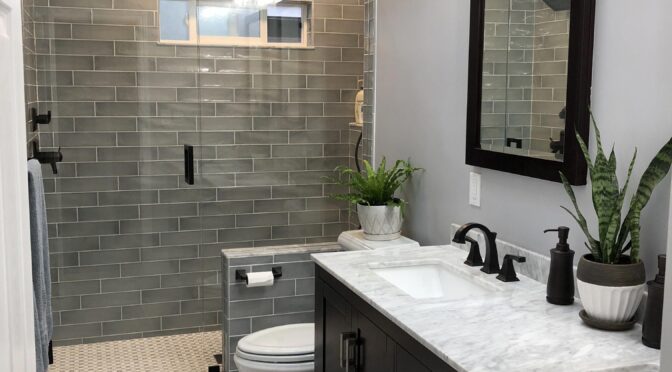Bathroom Remodel
Are you home owner wondering if a bath remodel is worth the investment or a seller of a property looking to recoup their investment? Building Cost Data and Cost Recovery Averages taken from nationwide data indicates that the bath remodel is listed as one of the best return on Investment projects you can do for a property. Upgrading fixtures, lighting, and finishes typically offers an ROI around 66.7%.
The bathroom remodel picture provided highlights a modern design with an emphasis on sleek, functional, and luxurious elements. Here’s an expanded description and some additional information:
Design Features:
- Vanity and Countertops:
- A minimalist, floating vanity with clean lines creates a sense of openness.
- Countertops are likely quartz or marble, which are durable, low-maintenance, and add a touch of elegance.
- Lighting:
- Well-placed lighting fixtures, such as recessed lights or wall-mounted sconces, provide adequate brightness and ambiance.
- LED mirrors might be included for additional functionality and style.
- Shower or Tub:
- Frame less glass shower enclosures make the space feel larger and allow for uninterrupted views of the tile work.
- High-end fixtures, like rain shower heads or handheld sprayers, enhance the spa-like experience.
- Tile and Flooring:
- Large-format tiles reduce grout lines and give a modern look.
- Materials like porcelain or ceramic tiles mimic natural stone and provide durability.
- Heated floors could be an added luxury feature.
- Color Palette:
- Neutral tones like whites, grays, and soft earth colors dominate, creating a timeless and serene environment.
- Accents in metallic finishes (chrome, brushed nickel, or matte black) add contrast and sophistication.
Benefits of a Bathroom Remodel:
- Improved Property Value: A bathroom remodel offers an average ROI of about 66.7%, making it a wise investment.
- Enhanced Functionality: Updates such as better storage solutions, energy-efficient fixtures, and modern layouts improve daily usability.
- Energy and Water Efficiency: Installing water-saving fixtures and LED lighting can lower utility bills.
- Aesthetic Appeal: A modern, well-designed bathroom can make a significant impression on potential buyers or simply enhance personal enjoyment.
Cost Considerations:
- Average Costs: A mid-range bathroom remodel can cost between $10,000–$25,000 depending on the extent of the renovations, materials, and labor.
- Luxury Remodels: High-end upgrades like custom cabinetry, premium fixtures, and natural stone materials can push the budget to $50,000 or more.
Customizations to Consider:
- Add smart technology like voice-controlled lighting or a smart shower system.
- Include built-in storage niches in the shower for a streamlined look.
- Opt for frame less LED mirrors with dimmable lighting.










